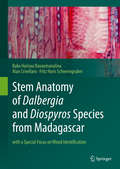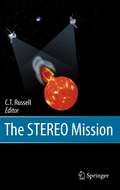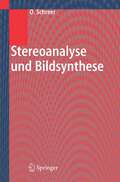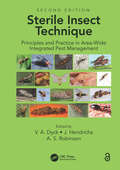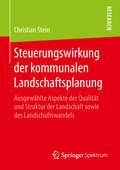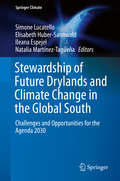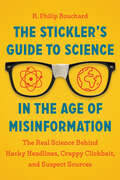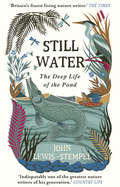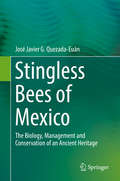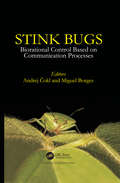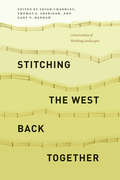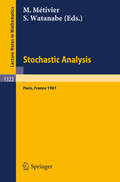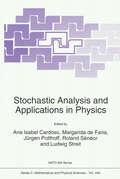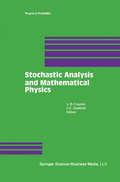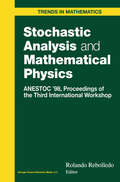- Table View
- List View
Stem Anatomy of Dalbergia and Diospyros Species from Madagascar: with a Special Focus on Wood Identification
by Bako Harisoa Ravaomanalina Alan Crivellaro Fritz Hans SchweingruberThis atlas offers anatomical descriptions of 19 Dalbergia and 31 Diospyros species, most of them endemic to Madagascar. Each species is illustrated with color micrographs of double-stained sections through the xylem, bark, and pith of stems, branches, and twigs. Further, a photograph of each plant and information on its height, DBH, habit, and geographical and elevational distribution in Madagascar are included. Dalbergia and Diospyros species provide highly-priced woods, which are intensively traded across the world and therefore highly endangered by illegal trade and harvesting. This book represents a response to the action plan for Diospyros and Dalbergia species regarding the establishment of a reference collection and reliable identification system for species listed by CITES, the Convention on International Trade in Endangered Species of Wild Fauna and Flora. Bringing together a wealth of material recently collected in different biogeographical regions of Madagascar and identified by the Missouri Botanical Garden, the book will appeal to plant scientists, taxonomists and practitioners involved in wood identification, and will help to safeguard the legacy of precious wood trading through proper identification.
Step into the World of Mathematics: Math Is Beautiful and Belongs to All of Us
by Samuli SiltanenModern life is increasingly relying on digital technology, which in turn runs on mathematics. However, this underlying math is hidden from us. That is mostly a good thing since we do not want to be solving equations and calculating fractions just to get things done in our everyday business. But the mathematical details do matter for anyone who wants to understand how stuff works, or wishes to create something new in the jungle of apps and algorithms. This book takes a look at the mathematical models behind weather forecasting, climate change prediction, artificial intelligence, medical imaging and computer graphics. The reader is expected to have only a curious mind; technical math skills are not needed for enjoying this text.
The STEREO Mission
by C. T. RussellC. T. Russell Originally published in the journal Space Science Reviews, Volume 136, Nos 1–4. DOI: 10. 1007/s11214-008-9344-1 © Springer Science+Business Media B. V. 2008 The Sun-Earth Connection is now an accepted fact. It has a signi cant impact on our daily lives, and its underpinnings are being pursued vigorously with missions such as the Solar TErrestrial RElations Observatory, commonly known as STEREO. This was not always so. It was not until the middle of the nineteenth century that Edward Sabine connected the 11-year geomagnetic cycle with Heinrich Schwabe’s deduction of a like periodicity in the sunspot record. The clincher for many was Richard Carrington’s sighting of a great whi- light are on the Sun, on September 1, 1859, followed by a great geomagnetic storm 18 hours later. But was the Sun-Earth Connection signi cant to terrestrial denizens? Perhaps in 1859 it was not, but a century later it became so. Beginning in the 1930’s, as electrical powergrids grew in size, powercompanies began to realize that they occasionally had power blackouts during periods of intense geomagnetic activity. This correlation did not appear to be suf ciently signi cant to bring to the attention of the public but during the International Geophysical Year (IGY), when geomagnetic activity was being scrutinized intensely, the occurrence of a large North American power blackout during a great magnetic storm was impossible to ignore.
Stereo(TYPE)
by Jonah Mixon-WebsterThe award-winning poet's darkly riotous debut, exploring stereotypes of Black male identity and sexuality in a corrupt systemLyrical, loud and radically urgent, Jonah Mixon-Webster's debut aims its sights at the words and images that shape us and the corrupt forces that stand in the way of our freedom. Stereo(TYPE) is a reckoning and a force. It is a revision of our most sacred mythologies - and a work of documentary poetry reporting from Mixon-Webster's hometown of Flint, Michigan, where untainted tap water is still not guaranteed and the legacies of racist policies persist. Challenging stereotypes through scenes scattered with satire, violence, and the extreme vagaries of everyday life, Mixon-Webster explores the places where space and body, race and region and sexuality and class meet and intersect. He invents visual/sonic forms, recasts poems as FAQs and transcripts, and dives into dreamscapes and modern tragedies. Interrogating language and the ways we wield it as both sword and shield, Stereo(TYPE) is a rapturous collection of vital and beautiful poems.
Stereoanalyse und Bildsynthese
by O. SchreerIn diesem Buch werden die mathematischen Grundlagen der 3D-Bildanalyse dargestellt. Dazu gehören die Modellierung von Kameras, die geometrischen Beziehungen zwischen zwei und mehreren Kameraansichten sowie eine Übersicht über Standardverfahren der Stereoanalyse. Ebenfalls führt der Autor in die mathematischen Grundlagen der Bildsynthese ein und gibt einen Überblick über existierende Verfahren. Das Buch überzeugt durch seine geschlossene Darstellung der mathematischen Grundlagen von Bildanalyse und -synthese in einheitlicher Form und Notation. Es wendet sich an Studierende der Elektrotechnik, der Kommunikationstechnik und Informatik sowie an Praktiker, die sich einen raschen Zugang zum Thema verschaffen wollen.
Sterile Insect Technique: Principles And Practice In Area-Wide Integrated Pest Management
by V. A. DyckThe sterile insect technique (SIT) is an environment-friendly method of pest control that integrates well into area-wide integrated pest management (AW-IPM) programmes. This book takes a generic, thematic, comprehensive, and global approach in describing the principles and practice of the SIT. The strengths and weaknesses, and successes and failures, of the SIT are evaluated openly and fairly from a scientific perspective. The SIT is applicable to some major pests of plant-, animal-, and human-health importance, and criteria are provided to guide in the selection of pests appropriate for the SIT. In the second edition, all aspects of the SIT have been updated and the content considerably expanded. A great variety of subjects is covered, from the history of the SIT to improved prospects for its future application. The major chapters discuss the principles and technical components of applying sterile insects. The four main strategic options in using the SIT — suppression, containment, prevention, and eradication — with examples of each option are described in detail. Other chapters deal with supportive technologies, economic, environmental, and management considerations, and the socio-economic impact of AW-IPM programmes that integrate the SIT. In addition, this second edition includes six new chapters covering the latest developments in the technology: managing pathogens in insect mass-rearing, using symbionts and modern molecular technologies in support of the SIT, applying post-factory nutritional, hormonal, and semiochemical treatments, applying the SIT to eradicate outbreaks of invasive pests, and using the SIT against mosquito vectors of disease. This book will be useful reading for students in animal-, human-, and plant-health courses. The in-depth reviews of all aspects of the SIT and its integration into AW-IPM programmes, complete with extensive lists of scientific references, will be of great value to researchers, teachers, animal-, human-, and plant-health practitioners, and policy makers.
Sterile Insect Technique: Principles And Practice In Area-Wide Integrated Pest Management
by Victor A. Dyck Jorge Hendrichs A. S. RobinsonThe sterile insect technique (SIT) is an environment-friendly method of pest control that integrates well into area-wide integrated pest management (AW-IPM) programmes. This book takes a generic, thematic, comprehensive, and global approach in describing the principles and practice of the SIT. The strengths and weaknesses, and successes and failures, of the SIT are evaluated openly and fairly from a scientific perspective. The SIT is applicable to some major pests of plant-, animal-, and human-health importance, and criteria are provided to guide in the selection of pests appropriate for the SIT. In the second edition, all aspects of the SIT have been updated and the content considerably expanded. A great variety of subjects is covered, from the history of the SIT to improved prospects for its future application. The major chapters discuss the principles and technical components of applying sterile insects. The four main strategic options in using the SIT — suppression, containment, prevention, and eradication — with examples of each option are described in detail. Other chapters deal with supportive technologies, economic, environmental, and management considerations, and the socio-economic impact of AW-IPM programmes that integrate the SIT. In addition, this second edition includes six new chapters covering the latest developments in the technology: managing pathogens in insect mass-rearing, using symbionts and modern molecular technologies in support of the SIT, applying post-factory nutritional, hormonal, and semiochemical treatments, applying the SIT to eradicate outbreaks of invasive pests, and using the SIT against mosquito vectors of disease. This book will be useful reading for students in animal-, human-, and plant-health courses. The in-depth reviews of all aspects of the SIT and its integration into AW-IPM programmes, complete with extensive lists of scientific references, will be of great value to researchers, teachers, animal-, human-, and plant-health practitioners, and policy makers.
Steuerungswirkung der kommunalen Landschaftsplanung: Ausgewählte Aspekte der Qualität und Struktur der Landschaft sowie des Landschaftswandels
by Christian SteinChristian Stein untersucht anhand einer deutschlandweiten repräsentativen Stichprobe von 600 Gemeinden, ob das Vorliegen eines Landschaftsplans einen positiven, d. h. steuernden Einfluss auf Landschaftszustand und -wandel innerhalb der Kommune hat. Mit Hilfe von Indikatoren zur Flächennutzung aus dem IÖR-Monitor, welche auf geotopographischen Daten basieren, werden statistische Zusammenhänge zur Struktur und Qualität der Landschaft ermittelt. Zudem wird geprüft, inwieweit die kommunale Landschaftsplanung den Landschaftswandel im Sinne einer ökologisch nachhaltigen Entwicklung positiv beeinflusst. Die Ergebnisse der Arbeit bestätigen, dass die kommunale Landschaftsplanung zu einer Verbesserung vor allem von Struktur und Qualität der Landschaft beiträgt. Bedeutsam sind dafür insbesondere deren Qualität und Wirkungsdauer sowie konkrete Umsetzungsvorschläge.
Stewardship of Future Drylands and Climate Change in the Global South: Challenges and Opportunities for the Agenda 2030 (Springer Climate)
by Simone Lucatello Elisabeth Huber-Sannwald Ileana Espejel Natalia Martínez-TagüeñaThis volume integrates a conceptual framework with participatory methodologies to understand the complexities of dryland socio-ecological systems, and to address challenges and opportunities for stewardship of future drylands and climate change in the global south. Through several case studies, the book offers a transdisciplinary and participatory approach to understand the complexity of socio-ecological systems, to co-produce accurate resource management plans for sustained stewardship, and to drive social learning and polycentric governance. This systemic framework permits the study of human-nature interrelationships through time and in particular contexts, with a focus on achieving progress in accordance with the 2030 United Nations Agenda for Sustainable Development. The book is divided into four main sections: 1) drylands and socio-ecological systems, 2) transdisciplinarity in drylands, 3) interculturality in drylands, and 4) the governance of drylands. Expert contributors address topics such as pastoralism and the characteristics of successful agricultural lands, the sustainable development goals and drylands, dryland modernization, and arid land governance with a focus on Mexico. The volume will be of interest to dryland researchers, sustainable development practitioners and policymakers.
The Stickler's Guide to Science in the Age of Misinformation: The Real Science Behind Hacky Headlines, Crappy Clickbait, and Suspect Sources
by R. Philip BouchardA wise and witty look at the real scientific principles behind some of the most commonly held—and widely spread—scientific misconceptions.
Still Water: The Deep Life of the Pond
by John Lewis-StempelThe Pond. Nothing in the countryside is more humble or more valuable. It’s the moorhen’s reedy home, the frog’s ancient breeding place, the kill zone of the beautiful dragonfly. More than a hundred rare and threatened fauna and flora depend on it. Written in gorgeous prose, Still Water tells the seasonal story of the wild animals and plants that live in and around the pond, from the mayfly larvae in the mud to the patrolling bats in the night sky above. It reflects an era before the water was polluted with chemicals and the land built on for housing, a time when ponds shone everywhere like eyes in the land, sustaining life for all, from fish to carthorse. Still Water is a loving biography of the pond, and an alarm call on behalf of this precious but overlooked habitat. Above all, John Lewis-Stempel takes us on a remarkable journey – deep, deep down into the nature of still water.
Stingless Bees of Mexico: The Biology, Management and Conservation of an Ancient Heritage
by José Javier Quezada-EuánThe stingless bees are the most diverse group of highly social bees and are key species in our planet’s tropical and subtropical regions, where they thrive. In Mexico, the management of stingless bees dates back centuries, and they were an essential part of the culture and cosmogony of native peoples like the Maya. In recent decades a vast amount of information has been gathered on stingless bees worldwide. This book summarizes various aspects of the biology and management of stingless bees, with special emphasis on the Mexican species and the traditions behind their cultivation. Much of the information presented here was produced by the author and the team of researchers at the Universidad Autónoma de Yucatán in the course of three decades of working with these insects. Given the breadth of its coverage, the book offers an equally valuable reference guide for academics, students and beekeepers alike.
Stinkbugs: Biorational Control Based on Communication Processes
by Andrej Cokl Miguel BorgesThis book presents an overview of the Pentatomidae species, covering their biology, phylogeny and reproductive behavior, main plants used in their diet and their nutritional exigencies, predatory stinkbugs, interactions between herbivores-plants and natural enemies, use of pheromone for monitoring phytophagous populations, and chemical and vibrational communication signals. It also presents possible technologies to be applied in field crops for pest management that could be developed as the basis of the interplay of stink bug communication signals.
Stinkbugs: Biorational Control Based on Communication Processes
by Andrej Čokl Miguel BorgesThis book presents an overview of the Pentatomidae species, covering their biology, phylogeny and reproductive behavior, main plants used in their diet and their nutritional exigencies, predatory stinkbugs, interactions between herbivores-plants and natural enemies, use of pheromone for monitoring phytophagous populations, and chemical and vibrational communication signals. It also presents possible technologies to be applied in field crops for pest management that could be developed as the basis of the interplay of stink bug communication signals.
Stirring It Up: How to Make Money and Save the World
by Gary HirshbergA true force for change, Gary Hirshberg has been at the forefront of movements working for environmental and social transformation for 30 years. From his early days as an educator and activist to his current position as President and CE-Yo of Stonyfield Farm, the world's largest organic yogurt company, Hirshberg's positive outlook has inspired thousands of people to recognize their ability to make the world a better place.In Stirring It Up, Hirshberg calls on individuals to realize their power to effect change in the marketplace--"the power of one"--while proving that environmental commitment makes for a healthier planet and a healthier bottom line. Drawing from his 25 years' experience growing Stonyfield Farm from a 7-cow start-up, as well as the examples of like-minded companies, such as Newman's Own, Patagonia, Wal-Mart and Timberland, Hirshberg presents stunning evidence that business not only can save the planet, but is able to simultaneously deliver higher growth and superior profits as well.Hirshberg illustrates his points with practical information and advice, as well as engaging anecdotes from what he calls "the bad old days" of his yogurt company: how a power outage left him milking cows by hand, how a dumpster fire revealed the need for better packaging, and his camel manure taste test challenge to a local shock jock. He also describes hands-on grassroots marketing strategies--printing yogurt lids with provocative, politically charged messages, handing out thousands of free samples to subway commuters to thank them for using public transit, and devising the country's first organic vending machine--explaining how these approaches make a much more powerful impact on consumers than traditional advertising.An inspiring book for business owners and managers as well as anyone interested in saving the environment, Stirring It Up demonstrates how companies can work to save the planet, while achieving greater profits and satisfaction, and how we can all use the power of conscious consumption to encourage green corporate behavior.
Stitching the West Back Together: Conservation of Working Landscapes (Summits: Environmental Science, Law, and Policy)
by Susan CharnleyNews headlines would often have us believe that conservationists are inevitably locked in conflict with the people who live and work on the lands they seek to protect. Not so. Across the western expanses of the United States, conservationists, ranchers, and forest workers are bucking preconceptions to establish common ground. As they join together to protect the wide open spaces, diverse habitats, and working landscapes upon which people, plants, and animals depend, a new vision of management is emerging in which the conservation of biodiversity, ecosystem integrity, and sustainable resource use are seen not as antithetical, but as compatible, even symbiotic goals. Featuring contributions from an impressive array of scientists, conservationists, scholars, ranchers, and foresters, Stitching the West Back Together explores that expanded, inclusive vision of environmentalism as it delves into the history and evolution of Western land use policy and of the working landscapes themselves. Chapters include detailed case studies of efforts to promote both environmental and economic sustainability, with lessons learned; descriptions of emerging institutional frameworks for conserving Western working landscapes; and implications for best practices and policies crucial to the future of the West’s working forests and rangelands. As economic and demographic forces threaten these lands with fragmentation and destruction, this book encourages a hopeful balance between production and conservation on the large, interconnected landscapes required for maintaining cultural and biological diversity over the longterm.
Stitching the West Back Together: Conservation of Working Landscapes (Summits: Environmental Science, Law, and Policy)
by Susan Charnley Thomas E. Sheridan Gary P. NabhanNews headlines would often have us believe that conservationists are inevitably locked in conflict with the people who live and work on the lands they seek to protect. Not so. Across the western expanses of the United States, conservationists, ranchers, and forest workers are bucking preconceptions to establish common ground. As they join together to protect the wide open spaces, diverse habitats, and working landscapes upon which people, plants, and animals depend, a new vision of management is emerging in which the conservation of biodiversity, ecosystem integrity, and sustainable resource use are seen not as antithetical, but as compatible, even symbiotic goals. Featuring contributions from an impressive array of scientists, conservationists, scholars, ranchers, and foresters, Stitching the West Back Together explores that expanded, inclusive vision of environmentalism as it delves into the history and evolution of Western land use policy and of the working landscapes themselves. Chapters include detailed case studies of efforts to promote both environmental and economic sustainability, with lessons learned; descriptions of emerging institutional frameworks for conserving Western working landscapes; and implications for best practices and policies crucial to the future of the West’s working forests and rangelands. As economic and demographic forces threaten these lands with fragmentation and destruction, this book encourages a hopeful balance between production and conservation on the large, interconnected landscapes required for maintaining cultural and biological diversity over the longterm.
Stitching the West Back Together: Conservation of Working Landscapes (Summits: Environmental Science, Law, and Policy)
by Susan Charnley Thomas E. Sheridan Gary Paul NabhanNews headlines would often have us believe that conservationists are inevitably locked in conflict with the people who live and work on the lands they seek to protect. Not so. Across the western expanses of the United States, conservationists, ranchers, and forest workers are bucking preconceptions to establish common ground. As they join together to protect the wide open spaces, diverse habitats, and working landscapes upon which people, plants, and animals depend, a new vision of management is emerging in which the conservation of biodiversity, ecosystem integrity, and sustainable resource use are seen not as antithetical, but as compatible, even symbiotic goals. Featuring contributions from an impressive array of scientists, conservationists, scholars, ranchers, and foresters, Stitching the West Back Together explores that expanded, inclusive vision of environmentalism as it delves into the history and evolution of Western land use policy and of the working landscapes themselves. Chapters include detailed case studies of efforts to promote both environmental and economic sustainability, with lessons learned; descriptions of emerging institutional frameworks for conserving Western working landscapes; and implications for best practices and policies crucial to the future of the West’s working forests and rangelands. As economic and demographic forces threaten these lands with fragmentation and destruction, this book encourages a hopeful balance between production and conservation on the large, interconnected landscapes required for maintaining cultural and biological diversity over the longterm.
Stitching the West Back Together: Conservation of Working Landscapes (Summits: Environmental Science, Law, and Policy)
by Susan Charnley, Thomas E. Sheridan, and Gary P. NabhanNews headlines would often have us believe that conservationists are inevitably locked in conflict with the people who live and work on the lands they seek to protect. Not so. Across the western expanses of the United States, conservationists, ranchers, and forest workers are bucking preconceptions to establish common ground. As they join together to protect the wide open spaces, diverse habitats, and working landscapes upon which people, plants, and animals depend, a new vision of management is emerging in which the conservation of biodiversity, ecosystem integrity, and sustainable resource use are seen not as antithetical, but as compatible, even symbiotic goals. Featuring contributions from an impressive array of scientists, conservationists, scholars, ranchers, and foresters, Stitching the West Back Together explores that expanded, inclusive vision of environmentalism as it delves into the history and evolution of Western land use policy and of the working landscapes themselves. Chapters include detailed case studies of efforts to promote both environmental and economic sustainability, with lessons learned; descriptions of emerging institutional frameworks for conserving Western working landscapes; and implications for best practices and policies crucial to the future of the West’s working forests and rangelands. As economic and demographic forces threaten these lands with fragmentation and destruction, this book encourages a hopeful balance between production and conservation on the large, interconnected landscapes required for maintaining cultural and biological diversity over the longterm.
Stitching the West Back Together: Conservation of Working Landscapes (Summits: Environmental Science, Law, and Policy)
by Susan Charnley, Thomas E. Sheridan, and Gary P. NabhanNews headlines would often have us believe that conservationists are inevitably locked in conflict with the people who live and work on the lands they seek to protect. Not so. Across the western expanses of the United States, conservationists, ranchers, and forest workers are bucking preconceptions to establish common ground. As they join together to protect the wide open spaces, diverse habitats, and working landscapes upon which people, plants, and animals depend, a new vision of management is emerging in which the conservation of biodiversity, ecosystem integrity, and sustainable resource use are seen not as antithetical, but as compatible, even symbiotic goals. Featuring contributions from an impressive array of scientists, conservationists, scholars, ranchers, and foresters, Stitching the West Back Together explores that expanded, inclusive vision of environmentalism as it delves into the history and evolution of Western land use policy and of the working landscapes themselves. Chapters include detailed case studies of efforts to promote both environmental and economic sustainability, with lessons learned; descriptions of emerging institutional frameworks for conserving Western working landscapes; and implications for best practices and policies crucial to the future of the West’s working forests and rangelands. As economic and demographic forces threaten these lands with fragmentation and destruction, this book encourages a hopeful balance between production and conservation on the large, interconnected landscapes required for maintaining cultural and biological diversity over the longterm.
Stitching the West Back Together: Conservation of Working Landscapes (Summits: Environmental Science, Law, and Policy)
by Susan Charnley, Thomas E. Sheridan, and Gary P. NabhanNews headlines would often have us believe that conservationists are inevitably locked in conflict with the people who live and work on the lands they seek to protect. Not so. Across the western expanses of the United States, conservationists, ranchers, and forest workers are bucking preconceptions to establish common ground. As they join together to protect the wide open spaces, diverse habitats, and working landscapes upon which people, plants, and animals depend, a new vision of management is emerging in which the conservation of biodiversity, ecosystem integrity, and sustainable resource use are seen not as antithetical, but as compatible, even symbiotic goals. Featuring contributions from an impressive array of scientists, conservationists, scholars, ranchers, and foresters, Stitching the West Back Together explores that expanded, inclusive vision of environmentalism as it delves into the history and evolution of Western land use policy and of the working landscapes themselves. Chapters include detailed case studies of efforts to promote both environmental and economic sustainability, with lessons learned; descriptions of emerging institutional frameworks for conserving Western working landscapes; and implications for best practices and policies crucial to the future of the West’s working forests and rangelands. As economic and demographic forces threaten these lands with fragmentation and destruction, this book encourages a hopeful balance between production and conservation on the large, interconnected landscapes required for maintaining cultural and biological diversity over the longterm.
Stochastic Analysis: Proceedings of the Japanese-French Seminar held in Paris, France, June 16-19, 1987 (Lecture Notes in Mathematics #1322)
by Michel Metivier Shinzo WatanabeStochastic Analysis and Applications in Physics (Nato Science Series C: #449)
by L. Streit Ana Isabel Cardoso Margarida De Faria Jürgen Potthoff Roland SénéorProceedings of the NATO Advanced Study Institute, Funchal, Madeira, Portugal, August 6--19, 1993
Stochastic Analysis and Mathematical Physics (Progress in Probability #50)
by A. B. Cruzeiro J. C. ZambriniThis volume represents the outgrowth of an ongoing workshop on stochastic analysis held in Lisbon. The nine survey articles in the volume extend concepts from classical probability and stochastic processes to a number of areas of mathematical physics. It is a good reference text for researchers and advanced students in the fields of probability, stochastic processes, analysis, geometry, mathematical physics, and physics. Key topics covered include: nonlinear stochastic wave equations, completely positive maps, Mehler-type semigroups on Hilbert spaces, entropic projections, and many others.
Stochastic Analysis and Mathematical Physics: ANESTOC ’98 Proceedings of the Third International Workshop (Trends in Mathematics)
by Rolando RebolledoThe seminar on Stochastic Analysis and Mathematical Physics started in 1984 at the Catholic University of Chile in Santiago and has been an on going research activity. Since 1995, the group has organized international workshops as a way of promoting a broader dialogue among experts in the areas of classical and quantum stochastic analysis, mathematical physics and physics. This volume, consisting primarily of contributions to the Third Inter national Workshop on Stochastic Analysis and Mathematical Physics (in Spanish ANESTOC), held in Santiago, Chile, in October 1998, focuses on an analysis of quantum dynamics and related problems in probability the ory. Various articles investigate quantum dynamical semigroups and new results on q-deformed oscillator algebras, while others examine the appli cation of classical stochastic processes in quantum modeling. As in previous workshops, the topic of quantum flows and semigroups occupied an important place. In her paper, R. Carbone uses a spectral type analysis to obtain exponential rates of convergence towards the equilibrium of a quantum dynamical semigroup in the £2 sense. The method is illus trated with a quantum extension of a classical birth and death process. Quantum extensions of classical Markov processes lead to subtle problems of domains. This is in particular illustrated by F. Fagnola, who presents a pathological example of a semigroup for which the largest * -subalgebra (of the von Neumann algebra of bounded linear operators of £2 (lR+, IC)), con tained in the domain of its infinitesimal generator, is not a-weakly dense.
